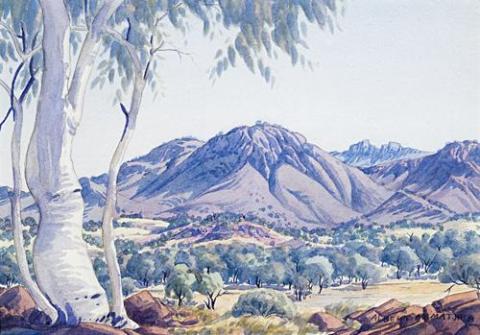MACDONNELL RANGES
Albert Namatjira
watercolour on paper
26.5 x 37.5 cm
signed lower right: ALBERT NAMATJIRA inscribed verso: "MACDONNELL RANGES", N-T-, BY ALBERT NAMATJIRA, ARANDA ARTS COUNCIL, No A150
Aranda Arts Council, Alice Springs
Private collection, Melbourne
Thence by descent, private collection, Melbourne
'Trees, positioned in the foreground, at the perimeter of horizontal formats, are a key element of the majority of prints responsible for introducing Albert Namatjira's art to the public. These were reproductions of paintings that generally depicted the MacDonnell Ranges Tywerentye from the perspective of a distant point in a dry creek bed or plain.
In most instances a giant river gum fills the frame to the left or right of the composition, in the shallow viewing space that Namatjira invites us to share. We gaze past this tree and the intervening middle ground to another motif: a mountain range. In some cases, the transitions in space introduce a variety of additional subjects. Are the subjects of these paintings the trees, the places they frame, or all of these? Without prior knowledge of their importance to other contexts, the viewer could choose to allow size to determine relative significance, however this may be misleading.
'As the art historians Ian Burn and Anne Stephen observed: 'A western reading (still resonant with ideas of the picturesque) seems instinctively to give priority to the trees and desires to use their vertical trunks to orient the viewer's relation to the expanse of landscape. For Namatjira, however, the overall landscape has priority and he painted it that way. His trees for example, often lean at angles which make them awkward for a non-aboriginal viewer to adopt as a point of entry to thelandscape. Namatjira frequently adopted a comparatively high horizon, placing trees in the landscape rather than silhouetted against the sky. Trees do not assert themselves as spatially discrete things and we even discover trunks reading as negative space or doubling as pathways superimposed over the terrain...'1
1. French, A., Seeing the Centre: The Art of Albert Namatjira 1902-1959, National Gallery of Australia, Canberra, 2002, pp. 117 & 131
